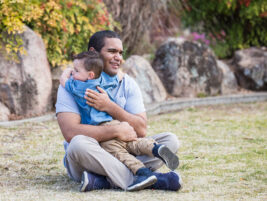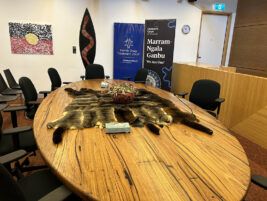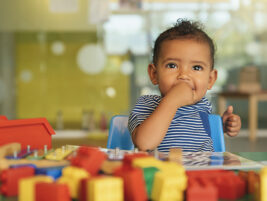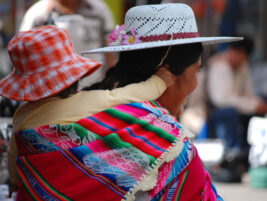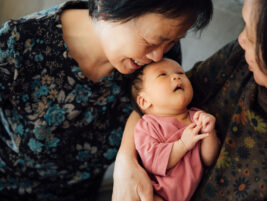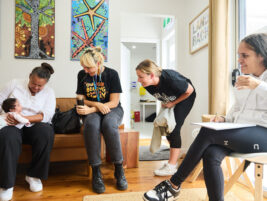We will present here some results of the studies we have conducted about the development and characteristics of the infant’s interaction with objects (toys).
The research work done by Emmi Pikler and her colleagues has enriched our knowledge of the developmental capacities of infants and young children. The systematic observation of infant’s gross-motor behavior in the context of free initiative reveals new perspectives into the recognition of so-far unknown abilities inherent to infants.
Observing the activities of the infants with objects (toys) in their nearest environment, following their own interest without the intervention or direct stimulation of the adult allowed us to understand in depth the role of manipulating objects in the cognitive development of the infant. It can be named in different ways, as fine motor activity, manipulation, manual activity, dialogue with objects, or visual – tactile exploration, or under the broader term of the infant’s “playing activity”.
I will present here the results of my research in this topic (which have never been translated from Hungarian until now).
To my best knowledge, there has not been any published study on the development and the richness of the manipulation activity in infants. This lack can probably be explained by two factors. One is that researchers are more interested by what and how the infant learns from adults, than from its spontaneous exploration. The second reason lies in the difficulty to observe free play in the traditional context of bringing up infants, where the infant is either tied to the mother’s body, or placed in a baby chair or a walker, or spends a long time in a sitting position that does not facilitate manipulation activity. An infant propped up in sitting or placed in a chair cannot choose simple, available toys placed around him, nor can reach for them out in case they are dropped or lost.
Aims of the study
We wished to examine
- The nature and the length of activities other than gross motor ones infants are able to perform during their first year of life.
- The different forms of spontaneous manipulation of objects infants are able to make.
Sample and procedure
I will present here a micro analytical study of 6 infants, ages 3-12 months living at our institute in a secure relationship. Data taken three times a week of more than 700 observation protocols, each time for 25 minute duration with quarter minute details form the basis of the study.
The observed infants were in stable, good emotional state and spent their wake time in their usual spacious playing area suitable for free movement. Simple, non over stimulating toys (to prevent distraction with sounds, lights or movements) are placed around the infant. There was no toy hanging above the infant’s head.
No change was made in the children’s environment for the sake of the study. The observer took a seat outside the playing area and was quietly and tactfully following and recording the infants activity.
When we summarized how much time the observed children spent with a specific form of activity, we took into account only forms of activity that lasted at least half a minute.
Results
1. The nature and the length of activities other than gross motor ones infants are able to perform during their first year of life.
- a) Getting acquainted with his own hands
As shown in Figure 1, four months-old infants spent an average of 5 out of the 25 minutes watching their hands. This activity then gradually decreased and almost disappeared by the 7th month.
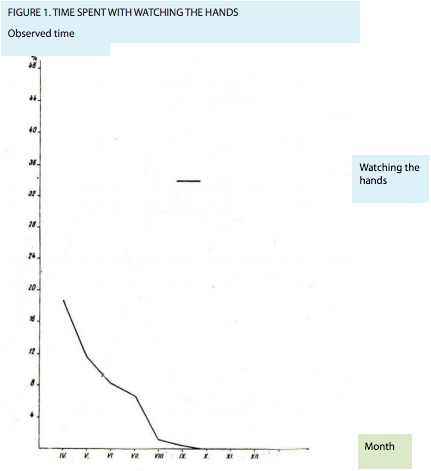
- b) Visual exploration
As shown in Figure 2, visual exploration was at its peak during the first eigth months and then declined.
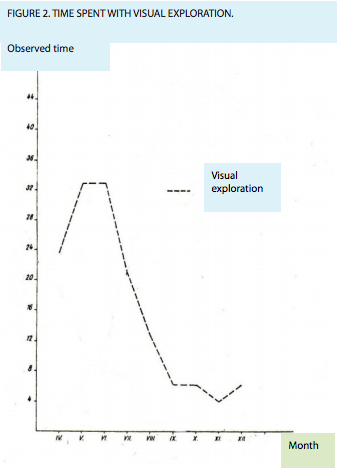
We have found this activity to be the most frequent during the 5th and 6th months, when it takes up an average of 8 and a half of the of the 25 observed minutes. In spite of the individual differences found among the infants, this pattern of change was observed in all of them, as shown in figure 3.

The infants’ gaze was primarily focused on the caregiver, but also towards other adults in the room, peers, toys and other objects. They displayed significant differences in the relative distribution of their attention, and to our surprise, these preferences remained stable over time.
- c) Manipulation of toys
As shown in Figure 4, manipulation of objects, the main focus of our study, gradually plays a more and more important role, starting from the 6th month, in parallel with the gross motor development. While visual exploration decreases, time spent with manipulation increases, in a kind of a developmental interchange.

Like for visual exploration, individual differences in the time spent in manipulation differentiated the infants, as shown in Figure 5.
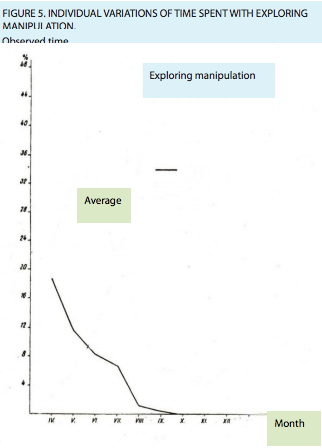
When manual activities appear, the increase of their quantity is rather fast: starting from the 9th month, children spend more than 10 minutes with manipulation on the average. Again, within this pattern, we found significant individual differences in the amount of time spent with manipulation of objects.
Figure 6 summarizes the patterns of change of activities over the first year
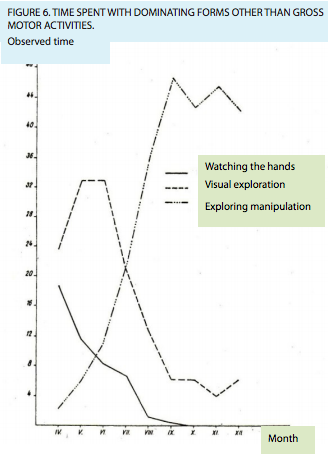
2. The different forms of spontaneous manipulation of objects infants are able to make.
In the course of activities with objects that are simple and easy to grasp, we observed a rich variety, starting with simple touch of the object to more and more sophisticated activities, such as placing one into the other at the end of the first year. The variety of activities was much larger than expected, and came up to over 100 forms of manipulation. We grouped them in 15 categories, as depicted in figure 7.
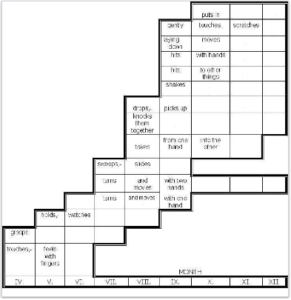
The pattern of acquisition was similar for all the infants (as it is with gross motor development): at first, the new form of activity is sporadic, then very frequent, and finally gradually declines though does not completely fade away, while in parallel, the next form of manipulation appears and develops following the same pattern.
The relatively frequent occurrence periods of typical forms of manipulation between the ages of 3-12 months.
The period of relatively frequent occurrence.
The time of maximum frequency in the children group of Anna Tardos.
Our hypothesis is underlined by the mathematical analysis of our data. The relatively frequent occurrence means a significantly high density in comparison to the data of the other months. As opposed to that the times of maximum frequency do not show a significant difference to the lowest data of the periods of relatively frequent occurrence either.
Here are some examples:
3 to 6 months-old infants typically manipulate and feel objects by holding them in their hands: watching, turning, moving, grabbing, bringing it to and from their mouth
From the 8th and 9th months, infants often plays with an object placed on the ground: slides the object held in his hand on a surface, waggles it on the base etc. It seems that holding the object in his hands is no longer so important to him in order to remain in contact with it.
Approximately at the same time a number of other activities also become frequent. It is the relocation of the objects in space. For example, taking from one hand into the other, knocking the objects held in the two hands together, knocking an object held in one hand to something else, dropping it and then picking up again, pushing it off, or rolling it far away, etc.
Each form of movement has its own specific role in the development of eye-hand coordination, in learning about the surface, form, weight and spatial location of the objects, and in the widening experience of how he, the infant, can impact his material environment, how he can move it or make it move.
Taking from one hand in the other for example seems a simple task, but in fact it requires the coordination of the opposite movement of the two hands: while one hand is letting go, the other, on the contrary, is closing on the object, and this has to be finely synchronized. Meanwhile, the parts of different shape or color of a non-symmetrical object become visible.
Around one year of age, manipulating two objects becomes predominant, and putting in and taking out become more and more frequent. These forms of activity play an especially important role in preparing logical thinking, in comparing dimensions and forms, and, later, in creating sets. It also has symbolic meanings, such as being together, separated and individualized. Infants spend their second year of life literally passionate about repeatedly putting in and taking out, emptying, and filling games.
Still bearing the symbolic meanings of the infant’s play in mind, we wondered whether the challenge of moving to a new room and adjusting to a new physical environment, would impact on the infants’ forms of manipulation (obviously, we try to avoid any unnecessary changes in the lives of the children, but sometimes, it is unavoidable, due to the structure of our two-level small building.) Indeed, we observed that in the days and weeks following the change, the frequency of the most recently acquired forms of manipulation decreased significantly, and it is only one month later that they returned to their pre-change frequency!
In contrast, the frequency of “drops and picks up” type of activity was unexpectedly very high and constantly rose in the first 10 days after the change of room. One of the symbolical meanings may be the mastery of a “loosing and finding” experience, which is especially challenging for institutionalized infants.
Discussion
The infant’s playing activity develops in parallel with gross motor development, and develop into more and more sophisticated forms. Infants observe the objects around themselves in every possible way, gather knowledge about its attributes, their size, weight, color, texture, whether they are rigid or flexible, collect sensory experiences, and learns what they can do with these objects, whether they are near or far, whether they need to make an effort, to reach out or perhaps change their position place in order to touch them, lift them, push or throw them away. Hence, infants pay attention to their own movements, the moving of their body, the objects surrounding them and the impact of their actions.
If nobody tells him what to play with and how, and nobody directs or distracts his attention, the child will be preoccupied with an object as long as it interests him. He can pause and later restart his attempts. He can vary the different forms of activities: watching around, manipulation, gross motor activity. In the course of free activities, variation of the different levels of attention can also be observed among infants in their first year of life. Repeating the action enables the infant to understand and memorize it for next time.
Experiencing the consequences of his own movements, the infant’s spontaneous activities become conscious and deliberate. In the course of discovering his environment, the infant asks himself questions and tries to find the answers. This continuous questioning and the desire to experiment characterize his attitude and his actions. Drawing conclusions, anticipation, memorizing, establishing relationships between the objects, objects and himself, objects and other persons, are all part of the cognitive processes embedded in the infant’s exploration and manipulation.
This attitude teaches him to set achievable tasks for himself. In this situation, devoid of external interventions, unsuccessful attempts do not create the feeling of failure in him. Accepting the momentary failure, and changing his strategy, is part of the learning experience the infant is acquiring through observing the impacts of his actions: He learns to learn. Keeping this learning process alive is more important than the individual results themselves.
As Henri Wallon pointed out, sensomotor activity is the root of thinking, one of the components of intelligence. In the course of the sensomotor activity the child discovers, learns, returns to his previously acquired knowledge to improve them. All this provides him the experience of some continuity, and it contributes to his basic sense of competence and security, as well as to building up a strong ego.
The latest research in developmental psychology has confirmed and provided new evidence the significance of the adult’s direct role to transmit knowledge. The infant gets tuned to the “educational situations” and imitates the activities of the adult with more efficiency than in the other, so-called random situations.
Therefore, infants and young children acquire different knowledge from the adult and from their own experiences. These two ways of learning are complementary and neither can replace the other. Learning through the free activity does not substitute the direct learning from the adult, but completes it.
Finally, as we have shown in this study, infants acquire the different forms of manipulation activities within a shorter period of time than was expected based on gross motor development. Therefore, the infant’s level of maturity should not be assessed solely based on his gross motor development, as it is often done, but also to his fine manipulation level, which in fact reflects his cognitive development.
Conclusion
In order to develop the optimal range and forms of sensorimotor development in the first year of life, the infant needs to be in positive emotional state, to be given time and space for free movement and exploration, to follow his own interest, to choose from toys around him, to “loose” them in order to find them again. We showed that this can be achieved in the context of an institution for parentless infants. Future studies are needed to confirm our clinical impression that this kind of experiences foster cognitive development and lower the risk for psychopathology, including attention deficit disorder, among these at-risk infants.
References
Egyed, K., Gergely, G. & Király, I. (2009). Tanulni másoktól és másokról (Learning from others and learning about others). Budapest.
Gergely, G. & Csibra, G. (2006). Sylvia’s recipe – The role of imitation and pedagogy in the transmission of human culture. Berg Publishers, Oxford.
Gergely, G., Egyed, K. & Király, I. (2007). A természetes pedagógiáról (On natural pedagogy). Budapest.
Pikler, E. (1969). Adatok a csecsemő mozgásának fejlődéséhez (Data to the Motor Development of the Infant – not available in English) (in French: Se mouvoir en liberté dés le premier age 1979) (in German: Lasst mir Zeit 1st edition 1988) (in Italian: Datemi tempo 1996)
Tardos, A. (1964). Megfigyelések a környezetváltozásnak a csecsemők játéktevékenységére gyakorolt hatásáról (Observations on the impact of the changing of the environment on the playing activities of infants). Budapest.
Tardos, A. (1967). A 3-12 hónapos csecsemők optikus és taktilmotoros viselkedése (The optical and tactile-motor behavior of 3-12 month old infants). Budapest.
Tardos, A. (1971). A spontán aktivitás különböző formáinak alakulása csecsemőknél (The development of the various forms of spontaneous activities of infants). Budapest.
Tardos, A. (1998). Les différentes formes de l’attention du nourisson au cours de son activité autonome et pendant ses interactions avec l’adulte. (The different forms of attention in the course of autonomous activities and interactions with the adults). Edition Eres.
Tardos, A. – David, M. (1991). De la valeur de l’activité libre du bébé dans l’élaboration du self. Résultats et discussions de quelques recherches de l’Institut Emmi Pikler á Budapest (The value of the free activities of the baby in the elaboration of the self. Some research results and discussions from the Pikler Institute in Budapest). Devenir.
Wallon, H. (1942). De l’acte á la pensée. Essai de psychologie comparée. (From acting to thinking. Essay of comparative psychology). Flammarion, Paris.
Recommended videos:
Kálló, É. – Mózes, E. (2009). Játék – Cselekvés – Gondolkodás (Playing – Acting – Thinking). Budapest.
Tardos, A. – Appell, G. (1990). A baby’s Attention at Play.
Authors
Tardos, Anna,
Child Psychologist,
Director of the Pikler Institute, Budapest,
Hungary



